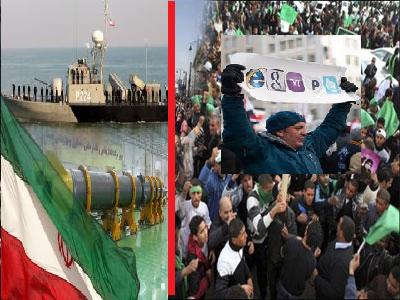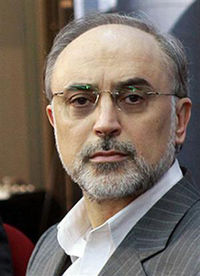Since the beginning of the current Arab revolutions, some journalist and experts have been discussing the influence of the Islamic Revolution of Iran over these historic events.
Yusuf Fernandez
 Since the beginning of the current Arab revolutions, in Tunisia and especially in Egypt, some journalist and experts have been discussing the influence of the Islamic Revolution of Iran over these historic events. However, views on this issue are determined by political ideologies and interests.
Since the beginning of the current Arab revolutions, in Tunisia and especially in Egypt, some journalist and experts have been discussing the influence of the Islamic Revolution of Iran over these historic events. However, views on this issue are determined by political ideologies and interests.
For example, Israeli politicians are trying to play down the significance of analogies between both revolutions. Defense Minister Ehud Barak has recently rejected comparisons between the overthrow of former Egyptian president Hosni Mubarak and the 1979 Islamic Revolution in Iran, in an interview with the ABC channel.
“I do not believe that something similar to the Iranian events of several years ago is happening now. I think that the Egyptians have their own way. I think that their direction is something which emerges very genuinely and in a spontaneous manner,” Barak stated. He added that, although he did not believe that the peace between Israel and Egypt was at risk, a rush to elections could bring the Muslim Brotherhood to power in the country.
IRAN THREW ITS WEIGHT BEHIND REVOLUTIONS IN TUNIS AND EGYPT
Nevertheless, Iranian experts support a very different view. Iran was the only Muslim country, which clearly supported the Tunisian and Egyptian revolutions. Iran's Foreign Ministry congratulated the Egyptian people on their victory against the oppressive rule of President Hosni Mubarak. “We congratulate the great nation of Egypt on this victory and we share their happiness,” Iranian Foreign Minister Ali Akbar Salehi said in a statement.
 Ali-Akbar Salehi - Iranian Foriegn Minister |
Iran's Parliament (Majlis) threw its weight behind the revolution in Egypt as millions of protesters were trying to force Mubarak to step down. Some 214 legislators in a statement backed the Egyptian revolution, citing the ongoing move in the North African state as a holy uprising and a historic awareness.
An Iranian lawmaker said the popular uprising against Mubarak´s 30-year rule was inspired by Iran's Islamic Revolution of 1979. IRNA quoted Gholam-Reza Mesbahi-Moqaddam as saying that the reality “of the Islamic Revolution's victory and the Iranian nations' hearty resistance has turned into a paradigm for the populace of Arab states,” he noted. “The Muslim Egyptians' uprising has turned this country into the center of Middle East developments and the world freedom-seekers and the Islamic nations in particular are anticipating the results of this holy revolution.”
The Iranian lawmakers described Iran's support for the Egyptian revolution as a spiritual one, based on common historical principles, adding that Egypt was regarded as the center of the Islamic movement in the 20th century, but the disloyal leaders of the state used the country's capabilities to serve the interests of those who usurped Muslims' rights, particularly the rights of Palestinians.
On 11 February, hundreds of thousands of Iranians marched in Tehran towards Azadi Square, chanting slogans denouncing the United States and Israel. Some also carried placards in support of the Egyptian and Tunisian revolutions. According to Iran's English-language Press TV, similar demonstrations “were held in 850 Iranian cities, as well as some 400 small towns and villages."
The marches marked the anniversary of the Islamic Revolution. Every year, the 10-day celebrations begin on February 1, the anniversary of the return to Iran of the late founder of the Islamic republic, Grand Ayatollah Ruhollah Khomeini, and culminate on February 11, the anniversary of the victory of the Islamic Revolution.
Although there are significant dissimilarities between the two revolutions, they are mainly formal. One is related to the different role of the armies in the two countries. Unlike Iran's generals´ intense loyalty to the Shah, the Egyptian army has a history of independence and refused to fire on the demonstrators. In Iran, the Shah´s army fired at demonstrators and massacred them in Tehran and other cities.
On the other hand, the leadership of the Iranian Islamic Revolution had a distinct and realistic plan to completely remake the state and create a new political society. The leadership of opposition to the Shah´s regime was unified under Khomeini in Iran, compared with a relative vacuum of leadership in the Egyptian revolution. Moreover, the Egyptian Revolution depended much more on latest technologies, particularly Internet and cellular phones, than the Iranian Revolution did.
However, in spite of all these differences and the fact that the Arab uprisings have been mainly driven by domestic concerns, both revolutions shredded a regional paradigm in which a US-backed dictator (the Shah in Iran or Mubarak in Egypt) was toppled by a people who rejected his pro-US and pro-Israeli humiliating policies. The Iranian Islamic Revolution was not an ordinary political or national move, but as we see today, after 32 years, it led a global awakening and a new movement in the Middle East and North Africa.
ARAB REVOLUTIONS AND THE IRANIAN ROLE IN THE MIDDLE EAST
 Most significantly, the current Arab revolutions, which are shaking the Arab world, have started to change the balance of power in the Middle East, in a similar way that the Islamic Revolution did in 1979. The US and Israel are very worried about the fall of Hosni Mubarak, their main puppet in the Middle East. Mubarak provided Israel with numerous favors vis-a-vis the Palestinians in Gaza and upheld and protected the Camp David Accords of 1978. Mubarak sealed the Rafah crossing into Gaza, prevented pro-Hamas demonstrations in Egypt, and urged Israel -behind closed doors- to continue its war to crush the Islamic Resistance in Palestine.
Most significantly, the current Arab revolutions, which are shaking the Arab world, have started to change the balance of power in the Middle East, in a similar way that the Islamic Revolution did in 1979. The US and Israel are very worried about the fall of Hosni Mubarak, their main puppet in the Middle East. Mubarak provided Israel with numerous favors vis-a-vis the Palestinians in Gaza and upheld and protected the Camp David Accords of 1978. Mubarak sealed the Rafah crossing into Gaza, prevented pro-Hamas demonstrations in Egypt, and urged Israel -behind closed doors- to continue its war to crush the Islamic Resistance in Palestine.In 2006, during the Israeli war on Lebanon, Mubarak attacked Hezbollah by blaming the Lebanese Resistance for the outbreak of a conflict against Israel despite all the evidences that showed that Israel had planned that aggression against Lebanon a long time before. Mubarak also criticized Iran when he appeared on al-Arabiyya TV in 2006 and said that Shiites of the Arab world were more loyal to Iran than they were to their own countries.
| The fall of Mubarak and other Arab dictators is likely to create a new reality in the Middle East |
In this way, the fall of Mubarak and other Arab dictators is likely to create a new reality in the Middle East. According to the New York Times, the current Arab revolutions are “bolstering Iran´s position” in the region. “Iran has already benefited from the ouster or undermining of Arab leaders who were its strong adversaries and has begun to project its growing influence, the analysts said. This week Iran sent two warships through the Suez Canal for the first time since its revolution in 1979, and Egypt´s new military leaders allowed them to pass.”
 “Iran is the big winner here,” a regional adviser to the US government, who spoke on the condition of anonymity because he was not authorized to speak to reporters, told the Times. “Qatar and Oman are tilting toward Iran... The trio of Arab regimes “aligned with the West”, which supported engaging Israel and containing Israel´s enemies, including Iran, Hamas and Hezbollah, have disappeared or are seriously weakened. The pro-American and pro-Israeli camp of “Egypt, Jordan and Saudi Arabia´s regimes are now in tatters” the adviser said. “Hosni Mubarak of Egypt has been forced to resign, King Abdullah of Jordan is struggling to control discontent in his kingdom and Saudi Arabia has been left alone to face a rising challenge to its regional role.”
“Iran is the big winner here,” a regional adviser to the US government, who spoke on the condition of anonymity because he was not authorized to speak to reporters, told the Times. “Qatar and Oman are tilting toward Iran... The trio of Arab regimes “aligned with the West”, which supported engaging Israel and containing Israel´s enemies, including Iran, Hamas and Hezbollah, have disappeared or are seriously weakened. The pro-American and pro-Israeli camp of “Egypt, Jordan and Saudi Arabia´s regimes are now in tatters” the adviser said. “Hosni Mubarak of Egypt has been forced to resign, King Abdullah of Jordan is struggling to control discontent in his kingdom and Saudi Arabia has been left alone to face a rising challenge to its regional role.”“If these ‘pro-American’ Arab political orders currently being challenged by significant protest movements become at all more representative of their populations, they will for sure become less enthusiastic about strategic cooperation with the United States,” FlyntLeverett and Hillary Mann Leverett, former National Security Council staff members, told the Times. They added that at the moment, Iran´s leaders feel that “the regional balance is shifting, in potentially decisive ways, against their American adversary and in favor of the Islamic Republic.”
 Turkey, a former key player of the US security strategy in the region, has been loosening its ties with the US and Israel and moving closer to Iran and Syria. In Lebanon, the pro-Western government led by Saad Hariri has fallen and a new government, which is supported by nationalist opposition, including Hezbollah, is going to be set up soon.
Turkey, a former key player of the US security strategy in the region, has been loosening its ties with the US and Israel and moving closer to Iran and Syria. In Lebanon, the pro-Western government led by Saad Hariri has fallen and a new government, which is supported by nationalist opposition, including Hezbollah, is going to be set up soon.With growing instability in the Middle East, including in Saudi Arabia, other big international powers understand that they need to expand their strategic relations with Iran. One of them is China, which counts heavily on Iran as a safe energy source for its economy. Beijing also depends on Iran´s support for its Central Asian policies and also as a convenient strategic pressure tool against the US. It is not without reason that China has held out more strongly in favor of Iran in recent weeks.
Like China, India, the other big Asian power, is also interested in developing its ties with Iran. Recently, India's National Security Adviser Shiv Shankar Menon, a key policymaker directly linked to Prime Minister Manmohan Singh, visited Tehran and met Iranian President Mahmud Ahmadinejad there. Menon praised Ahmadinejad because “many of the predictions you (Ahmadinejad) had about the political and economic developments in the world have come to reality today and the world order is going under basic alterations, which has necessitated ever-increasing relations between Iran and India”. He also called for “the establishment of comprehensive relations with Iran, including strategic ties”.
Al-Manar.com.lb is not responsible for the content of this article or for any external internet sites. The views expressed are the author's alone.
